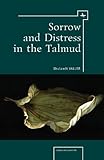Sorrow and distress in the Talmud / Shulamit Valler ; translated from Hebrew by Sharon Blass.
Material type: TextLanguage: English Original language: Hebrew Series: Judaism and Jewish lifePublication details: Boston : Academic Studies Press, 2011.Description: 1 online resource (313 pages)Content type:
TextLanguage: English Original language: Hebrew Series: Judaism and Jewish lifePublication details: Boston : Academic Studies Press, 2011.Description: 1 online resource (313 pages)Content type: - 9781618111128
- 1618111124
- 1936235366
- 9781936235360
- Talmud -- Criticism, interpretation, etc
- Talmud -- Critique, interprétation, etc
- Talmud
- Sadness -- Religious aspects -- Judaism
- Distress (Psychology) -- Religious aspects -- Judaism
- Grief -- Religious aspects -- Judaism
- Tristesse -- Aspect religieux -- Judaïsme
- Chagrin -- Aspect religieux -- Judaïsme
- RELIGION -- Judaism -- Talmud
- Sadness -- Religious aspects -- Judaism
- Grief -- Religious aspects -- Judaism
- 296.1/25 23
- BM501 .V3513 2011eb
- online - EBSCO
| Item type | Current library | Call number | URL | Status | Notes | Barcode | |
|---|---|---|---|---|---|---|---|
 eBook
eBook
|
Biblioteca "Angelicum" Pont. Univ. S.Tommaso d'Aquino Nuvola online | online - EBSCO (Browse shelf(Opens below)) | Online access | Not for loan (Accesso limitato) | Accesso per gli utenti autorizzati / Access for authorized users | (ebsco)500823 |
Includes bibliographical references and indexes.
In English, with occasional Hebrew.
Table of Contents -- Preface -- Chapter One Sorrow (Mitzta�er) -- Chapter Two Extreme Sorrow (Hulshat da�at) -- Chapter Three Weeping (Bechi) -- Chapter Four Grief over the Death of Children -- Chapter Five The Encounter Between the Sages and the Women Accompanying Them in Times of Distress -- Afterword -- Appendix Hulshat da�at and Self-Psychology -- Bibliography -- Index of Biblical and Talmudic Figures -- Index of Biblical and Talmudic References -- Index of Topics -- Also Published by Academic Studies Press
Both the Babylonian Talmud and the Jerusalem Talmud depict a wide range of sorrowful situations tied to every level of society and to the complexities of human behavior and the human condition. The causes and expressions of sorrow amongst the Sages, however, are different from their counterparts amongst common people or women, with descriptions varying between the Babylonian and the Jerusalem Talmud. In Sorrow and Distress in the Talmud, Valler explores more than 50 stories from both the Babylonian and the Jerusalem Talmuds, focusing on these issues.


